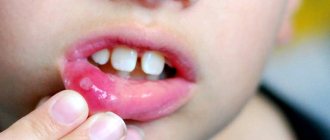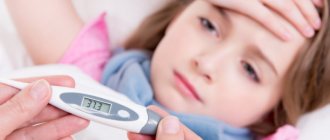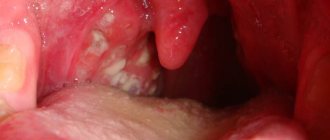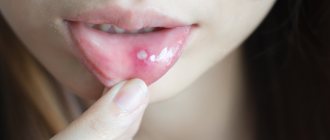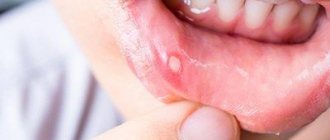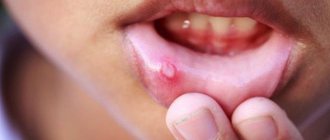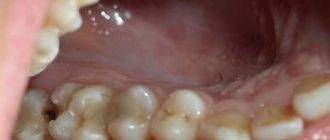In the treatment of cancer, inflammatory processes in the oral mucosa are by no means uncommon, but rather even a pattern, because increased chemical exposure to the body reduces its resistance to infections, most of which enter through the mouth.
In addition, chemotherapy treatment affects the body's cell division mechanism. Due to this, over time, damaged tumor cells become fewer and fewer, but healthy cells are also damaged and for some time lose their natural ability to self-heal. This leads to damage to the epithelial cells that make up the oral mucosa, which, in turn, leads to stomatitis. Due to the drying out of the mucous membrane, small ulcers and cracks appear, and the gums often begin to bleed.
Complications from the digestive system
The most common complications of the digestive system during drug therapy include:
- Nausea and vomiting
- Loose stools (diarrhea)
- Stomatitis
Nausea and vomiting are the leading complaints among patients. The cause of nausea and vomiting is still not completely clear. Chemotherapy is known to cause nausea and vomiting by releasing emetogenic compounds such as dopamine, serotonin and substance P, which act on receptors in the digestive system and central nervous system, triggering the gag reflex. In other words, the development of nausea and vomiting is associated with irritation of receptors in the stomach and brain.
Using Probiotics
The microflora of the oral cavity, like the intestinal flora, is divided into beneficial, pathogenic and opportunistic. Accordingly, for successful treatment of stomatitis after chemotherapy, the number of beneficial bacteria must be sufficient to suppress harmful microorganisms that can aggravate the course of the disease. Probiotics are found both in food products (fermented milk, fermented) and in special preparations. Among the drugs, it is worth choosing liquid ones, which contain live strains of bacteria that can quickly begin their work.
Consult your doctor; for some types and complications of cancer, probiotics are not recommended for use.
Types of nausea and vomiting
The type of nausea and vomiting is determined by the time it occurs during the chemotherapy cycle:
acute - on the first day after the administration of cytostatics
delayed - within 2-5 days after the administration of cytostatics.
With subsequent administrations of the drug, “premature vomiting” (nausea and vomiting “waiting”) may occur - within several hours before the administration of cytostatics. It usually develops in patients who previously received highly emetogenic PCT regimens and suffered from its complications. It can be provoked by smells, tastes, the sight of objects and surroundings reminiscent of treatment. To prevent such nausea and vomiting, tranquilizers, psychotraining, and hypnosis are used.
Unfortunately, often patients may not report the development of complications. This behavior is due to widespread misconceptions about the chemotherapy process, such as:
- “Nausea and vomiting always accompany chemotherapy”
- “The presence of nausea and vomiting indicates the effectiveness of chemotherapy”
- “My chemotherapy will be canceled!”
- “There are no effective treatments for nausea and vomiting”
Some patients downplay the strength and significance of developing complications and do not want to further disturb the medical staff. This behavior greatly impedes constructive interaction between patient and doctor and creates additional health risks.
Dietary recommendations if cancer is diagnosed
You should limit your intake of simple sugars or replace them with aspartame, acesulfame, sorbitol or xylitol. Consumption of foods with spicy spices that irritate the mucous membrane should be limited. Preferred food is warm and with mild aromas, with minimal amounts of spices. Avoid fruit juices, particularly sour fresh fruits, both because they taste too strong and because of the risk of enamel erosion. Reduce consumption of coffee, tea and thirst-causing foods (dry biscuits, crackers, chips). Alcohol in any form should be excluded from the diet.
It should be borne in mind that maintaining a balanced diet in patients undergoing chemotherapy and/or radiation therapy poses specific difficulties. There is a change in taste, difficulty swallowing, and nausea and vomiting may occur. In addition, drugs recommended during treatment have an adverse effect on some food ingredients, drugs such as neomycin reduce the absorption of vitamins K and D, methotrexate, in general, affects the metabolism of vitamins, in particular, it reacts with folic acid and most drugs can lead to anorexia.
Nutritional compositions available in pharmacies, in liquid form, containing a set of vitamins, microelements and amino acids that provide calories and nutrients, should complement the daily diet of cancer patients.
In the case of stomatitis, the most effective drugs are oil-based keratoplasties - aecol, vitamin A, E. But their healing effect is not high, these drugs are nothing more than vitamins.
There is a need to use more advanced and effective specialized drugs.
EGF Epidermal growth factor. Belongs to the group of polypeptides. Only a few of its forms are approved for use in Russia; in particular, it is offered by the Moscow company REPLERY in the form of a spray for application to the mucous membrane or skin. The wound healing effect is very high, as is the cost of the drug. It is still used in medicine to a limited extent, but is very widely represented in cosmetology and is included in many cosmetic preparations.
Palifermin is a recombinant human keratinocyte growth factor, a drug close to EGF, certified and used in the European Union
SUMMARY
Prevention of stomatitis in every patient with cancer should be part of therapy. It has a chance of success only due to the proper motivation of the patient himself, his desire and self-discipline. Of course, if a person has cancer, if the doctor sees symptoms of cancer in the mouth, then a request to replace a filling or install prosthetics causes a sarcastic smile in the patient. In addition to unpleasant sensations, there are also expenses, and cancer treatment itself is not cheap.
And then these dentists start the old boring song about the need to have clean teeth. But it should be recalled that dental problems are one of the provoking factors for the occurrence of cancer. Those. Many ended up at the oncologist precisely because of untreated teeth.
And in our practice, we have encountered similar cases. In particular, I remember a case when we diagnosed a patient with cancer that developed under an old removable denture. This was malignancy of the area of the mucous membrane under the prosthesis with deep ulceration and reaction of the regional lymph nodes, classic leukoplakia. Our diagnosis was subsequently confirmed.
But even if the disease does appear, oncologists have developed effective treatment regimens and practice has shown that they are successful in most cases. But oncologists themselves admit that it is not always possible to fully carry out therapy due to the occurrence of complications associated with concomitant diseases.
Any therapy for cancer, and indeed all tumors, is based on one basic principle. Tumor cells are in the stage of constant, avalanche-like division and in this state they have one vulnerability - they are sensitive to X-rays and cytostatic drugs.
Unfortunately, epithelial cells of the gastrointestinal tract and oral cavity are also renewed very intensively. In therapy, they also become targets, although to a lesser extent. There is a chance to keep them intact, eliminating damaging factors.
In conclusion, I would like to warn people against mistakes. The proposed methods of treatment and prevention of complications were found through much trial and error. Medicine is not omnipotent and will never be omnipotent - even if humanity learns to treat all known diseases, they will simply be replaced by new ones and everything will repeat all over again.
But in medicine there are truisms and laws, unshakable axioms. Their fulfillment serves the purpose of recovery. Another thing is that the disease may turn out to be stronger, this is how this world works.
Attempts to reinvent what has already been created and tested by practice are constantly being made; people are ready to believe in a fairy tale, because only a fairy tale always gives hope.
Kerosene with vodka, treating cancer with soda, experiments with excrement - this makes a healthy person smile. But consciousness changes if a formidable illness holds you by the throat. If the doctor sets you up for a difficult and difficult path, then you want to go faster and faster.
If only diseases could be cured so easily, simply by discovering a method.
At the same time, if this is just the beginning of the disease, and the treatment is carried out vigorously and correctly, complete recovery occurs. Diseases are also not omnipotent.
GLOSSARY.
Erythema. Redness of the skin or mucous membranes due to hemostasis in the capillaries.
Erythroplasia (erythroplakia). Red papular or macular lesions of the mucous membrane. Malignancy may occur.
Etiology. Study of the causes of the disease. On the other hand, the cause of the disease.
Scab. A structure formed on tissue caused by cauterization or the application of some destructive substance.
Estrogen. General term for naturally occurring steroid hormones containing the core estrone, estriol estadiol, etc. secreted from the testes, ovaries and placenta; stimulates anabolic protein actions and has a positive effect on nitrogen balance.
Exogenous. Due to external reasons; not occurring in the body.
Fibroblasts. Connective tissue cells; a flattened, irregularly branched cell with a large oval nucleus, which is responsible, in part, for the production and remodeling of the extracellular matrix.
Fibroblast growth factor. A family of growth factors with mitogenic properties for fibroblasts and mesodermal cell types.
Fibronectin. High molecular weight (450 kDa) glycoprotein, consisting of two polypeptides connected by disulfide bonds; the functional domains of the molecule have an affinity for cells and components of the extracellular matrix; found on the surface of cells, in connective tissue, in the blood,
Fibrosis. Fibrous changes in the mucous membranes, especially the gums, resulting from chronic inflammation. Fibrous gums may appear healthy in appearance, masking the underlying disease.
Flow cytometry. Measuring the physicochemical characteristics of individual cells as they move past optical or electronic sensors; can be used to detect specific cells in a mixed population; used to determine the effects of drugs, hormones, chemicals.
General anesthesia. Drug-induced switching off of consciousness, during which patients do not respond to stimulation, even painful stimulation. The ability to independently maintain respiratory function is often impaired. Patients require assistance in maintaining airway function.
Glucocorticoids. A group of corticosteroids secreted from the adrenal cortex (such as cortisol or dexamethasone) that are involved in the metabolism of carbohydrates, proteins, and fats; which regulate the level of glycogen in the liver and blood sugar levels by changing gluconeogenesis.
Glycosaminoglycan. A polysaccharide chain consisting of hexosamines alternating with another carbohydrate residue. proteoglycan component.
GRAFT GRAFT. Any allograft in the form of granules or xenograft granular material placed for the purpose of increasing bone volume or regenerating a bone defect.
Gram stain. A method of classifying bacteria into two groups based on the color of their cell wall, after they are stained either violet (positive) or pale red (negative). Accordingly, bacteria are divided into gram-positive and gram-negative
Growth factors. A diverse group of polypeptides that play an important role in regulating the growth and development of various organs.
Humoral immunity. The immune response is mediated by the secretion of immunoglobulins (antibodies) produced by activated B cells (plasma cells) against antigens.
Hyperkeratosis. Excessive formation of keratin in epithelial cells.
Hypermineralization. The presence of unusual amounts of mineral elements in calcified tissue.
Hyperkeratosis. An abnormal increase in the thickness of the epithelial layer (stratum corneum) of the epithelium.
Hyperostosis. Localized bone overgrowth. See also exostosis.
Hyperplasia. An increase in the size of the tissue structure due to an increase in the number of cells.
Hypophosphatasia. Hypophosphatasia: An inborn error of metabolism characterized by a deficiency of alkaline phosphatase in serum and bone tissue, resulting in the formation of defective bone and cementum.
Hypoplasia. Defective or incomplete development.
There is a flap on the leg. Any flap that is mobilized to a new location using lateral incisions but retains its natural connection at the base to preserve its blood supply.
Autograft graft. Bone chips from the donor site to the recipient site within the same individual. Also known as autogenous graft.
Block graft. Graft. An autogenous or allogeneic bone graft in the form of a block, used to augment bony areas.
Foreign body. an unusual substance in the tissues or body cavity.
Foreign body reaction. Granulomatous reaction around foreign material in a tissue or organ; often characterized by the appearance of giant cells. This can manifest as acute or chronic inflammation of the gums and can lead to inflammation or purulent lesions.
Bridle. A fold of mucosal tissue that attaches the lips and cheeks to the alveolar mucosa (and/or gingiva) and underlying periosteum.
Fistula. Stoma. A pathological canal connecting the cavities of two hollow organs or into an organ cavity with the surface of the body.
Hydroxyapatite (HA). An inorganic compound, CA(P04)6(OH)2, found in the matrices of bones and teeth, which provides rigidity to these structures. Synthetic forms are used in medicine to replace intraosseous defects, as well as to coat dental implants.
Hemostatic instrument. A tool that can be used to stop bleeding. Clamps, clips.
Risk factors for developing nausea and vomiting
There are various causes that predispose to nausea and vomiting. First of all, these are the characteristics of the drug used or their combination.
The individual characteristics of the patient are of great importance:
- Age under 50
- Female
- Tendency to motion sickness in transport
- Presence of morning sickness during pregnancy
- Having had nausea and vomiting during a previous chemotherapy cycle
- Rare alcohol consumption
Chemotherapy is most difficult for women and patients under 30 years of age.
Feeling after chemotherapy
How you feel after chemotherapy depends not only on the combination of drugs used and their doses, but also on the initial state of health, gender (women have more complications), and psychological characteristics. It is clear that after the cycle you feel worse than before.
All cycles are tolerated differently, and adverse reactions after the first chemotherapy are not similar to the toxicity of subsequent cycles. Negative manifestations from the blood, heart muscle, kidneys and nervous system may worsen. Mucositis, on the contrary, is easier because the most sensitive layers of mucous cells have already died and strong scar tissue has formed in their place.
Well-being can be improved, it is also possible to speed up tissue restoration, and with a future course, some of the adverse reactions can be transferred to a mild degree or seriously leveled out, as they can do in our clinic.
Efficacy of antiemetic therapy
Treating complications of chemotherapy, such as nausea and vomiting, can be beneficial. The arsenal of drugs that provide the prevention and treatment of nausea and vomiting is very large. Their combined use can prevent the appearance of these symptoms in 90% of cases.
Full control: no vomiting after administration of antiemetic drugs,
mild nausea
Partial control: one episode of vomiting or mild nausea
Prevention methods
- Get a dental exam. Visit your dentist before starting cancer treatment to take care of any unresolved dental problems, such as gum disease, tooth decay, or teeth that need to be removed. Any pain or infection in your mouth will only get worse as you begin treatment.
- Tell your doctor if you already have mouth ulcers.
- In some cases, medications can prevent ulcers from occurring during chemotherapy. For example, people who suffer from canker sores due to the herpes simplex virus can take antiviral medications to prevent such complications during treatment. Mouth rinsing with the drug dexamethasone may help avoid stomatitis in people receiving the targeted drug everolimus.
- Take care of your teeth. Get into the habit of brushing your teeth and rinsing your mouth several times a day. Check the labels on mouthwashes and avoid products that contain alcohol.
- Stop smoking. If you smoke, quit. Smoking during treatment will make it difficult for your mouth to heal.
- Eat a diet rich in fruits and vegetables. You will need vitamins and nutrients to help your body fight infections during treatment.
Lifestyle and nutrition during chemotherapy
Lifestyle and nutrition are of great importance during chemotherapy. Physical activity, fresh air, and breathing exercises are recommended. Physical activity helps to avoid complications.
It is necessary to eat properly - hunger increases nausea. Eating should begin before hunger appears, and you should eat slowly and in small portions.
Other recommendations:
- Avoid eating foods with strong odors
- Avoid fried, fatty and sweet foods
- Food should be at room temperature or chilled
- It is necessary to drink enough liquid, but not during meals
- Try not to cook your own food
- Light, quickly digestible foods are recommended: boiled potatoes, yoghurt, chicken, boiled beef, low-fat broths, rice or oatmeal, crackers.
Degree of complications
Side effects are classified according to severity as follows:
- 0 degree - no manifestations;
- 1st degree - minor manifestations that do not change the quality of life;
- Grade 2 - moderate symptoms that force the patient to limit activity; it is difficult to cope with them without treatment;
- Grade 3 - severe manifestations requiring hospitalization;
- Grade 4 - life-threatening requires emergency treatment measures.
For each cytostatic drug, grade 3-4 toxicity is calculated as a percentage, but the use of drug combinations can lead to unplanned consequences.
Stomatitis
Stomatitis is an inflammation of the oral cavity that occurs in about a third of patients. Inflammation is most often caused by the activation of bacterial and fungal infections in areas of the mucous membrane damaged by cytostatics. Stomatitis is a manifestation of hidden complications.
Signs of stomatitis:
- "tingling", pain in the mouth
- change in taste
- increased salivation
- redness of the mucous membrane
- the appearance of ulcers
- bleeding gums
- swelling of the tongue and gums
In the absence of timely treatment, severe inflammation, dehydration may develop, and eating will become difficult.
The most common complications and unpredictable reactions
Sometimes antitumor therapy has such a severe toxic effect on the body that the quality of life becomes worse than during the disease. This may be accompanied by the following symptoms:
- changes in taste, loss of appetite, nausea, vomiting;
- weakness not associated with physical activity, dizziness, drowsiness;
- muscle pain, neuropathy (numbness of the hands, feet);
- depressed state, panic attacks;
- decreased cognitive abilities – deterioration of memory, concentration;
- bowel disorder - diarrhea or constipation;
- increased body temperature;
- hair loss, change in color of nail plates and skin;
- swelling, redness, ulceration in the mouth area;
- in men – loss of libido and erection, reproductive functions; in women – failure of the ovaries.
Weakened immunity and an increased risk of bleeding are directly related to changes in blood composition, namely a drop in the number of neutrophils and platelets. After such destructive symptoms that do not go away on their own, recovery from chemotherapy for oncology will be required.
The WHO classification considers several degrees of severity of side effects:
- 0 – no changes in condition and laboratory tests are observed;
- I – recording of minor deviations that do not affect the general condition and do not require correction;
- II – moderate changes in internal organs, noticeable deterioration in test data and decreased activity. The patient needs therapeutic assistance;
- III – severe violations requiring the cancellation of sessions and mandatory intensive somatic treatment;
- IV – changes in the body that pose a threat to human life.
Predisposing factors for the development of stomatitis
- Poor oral hygiene (caries, dentures, gingivitis, tonsillitis, etc.)
- Smoking, drinking alcohol
- Spicy, hot, salty food
Prevention of stomatitis includes maximum oral hygiene before starting chemotherapy. Very often, we send patients to the dentist before starting treatment to avoid subsequent complications.
Prevention of stomatitis:
- Assessment of the condition of teeth and mucous membranes before and during treatment
- Complete sanitation of the oral cavity (treatment of caries, use of dental elixirs)
- Careful oral hygiene and diet
Hygiene measures include brushing your teeth with a soft toothbrush, rinsing with a weak solution of hydrogen peroxide, furatsilin, chlorhexidine.
If stomatitis does develop, it is necessary to spare the oral cavity as much as possible when eating - exclude those foods that can cause irritation.
Nutrition for stomatitis:
- Avoid sour fruits and citrus fruits
- Drink up to 1.5 – 2 liters of fluid per day
- We recommend ready-made nutritional formulas for children, cottage cheese, yoghurts, ice cream, soft cheeses, cereals, stewed and steamed beef and poultry, soufflés, puddings
Chemotherapy itself does not impose restrictions on nutrition, but to speed up the restoration of damaged cells, we recommend consuming more protein and generally healthy, nutritious, varied foods.
Treatment of stomatitis:
- Rinsing with warm decoctions of chamomile, sage, oak bark, St. John's wort, soda solution, chicken protein
- Mouth rinse "Tantum-Verde", irrigation with aerosols ("Proposol", "Gexoral")
- Lubricating ulcers with sea buckthorn oil, solcoseryl, actovegin
- Lozenges for resorption (Septolete, Faringosept)
Local treatment is aimed at removing plaque from the oral cavity and maintaining the moisture of the mucous membranes. Anesthesia with local anesthetics (procaine, lidocaine). With the development of esophagitis, antacids, enveloping agents, and antispasmodics are used.
Oral care during cancer treatment
Dental care
Before starting cancer treatment, your doctor may advise you to see a dentist. If you need to see a dentist during treatment, ask the dentist to call your Memorial Sloan Kettering (MSK) doctor first.
Brushing your teeth
- Brush your teeth and tongue gently within 30 minutes after eating. Use a small, soft-bristled brush. If the pain in your mouth is too severe for a regular soft toothbrush, you can purchase a brush with super-soft bristles at the pharmacy. Here are some examples of such brushes: Biotene® Supersoft Toothbrush;
- extra-soft gentle toothbrush Sensodyne® Extra Soft;
- Colgate® 360 Sensitive Pro-Relief Extra-Soft Toothbrush with Compact Head;
- soft toothbrush with compact head Oral-B® Indicator 35.
Flossing
Brush your teeth with unwaxed dental floss once a day before bed. If you haven't been doing this regularly before treatment, don't start now.
Rinsing
- Rinse your mouth every 4-6 hours or more often as needed. Use one of the following rinses: one quart (4 cups (500 ml)) water mixed with 1 teaspoon salt and 1 teaspoon baking soda;
- one quart of water (500 ml) mixed with 1 teaspoon of salt;
- one quart of water (500 ml) mixed with 1 teaspoon of baking soda;
- water;
- A mouthwash that does not contain alcohol or sugar, such as Biotene® PBF or BetaCell™ mouth rinses.
Moisturizing lips
- Use a lip moisturizer (such as Aquaphor®, Vaseline®, Eucerin Original®, or A&D® Ointment) 4 to 6 times daily to prevent dry lips.
- Do not apply lip moisturizers 4 hours before your head and neck radiotherapy session.
to come back to the beginning
The effect of chemotherapy on female fertility
Chemotherapy can lead to decreased levels of female sex hormones and premature menopause. Symptoms such as:
- Dryness, itching in the vagina, pain and discomfort during sexual intercourse.
- Hot flashes.
- Decreased sexual desire.
- Weakness, emotional instability, tendency to depression.
- Irregular periods or absence of them.
- Sweating at night.
Hormonal therapy, relaxation techniques, and artificial vaginal lubricants help to cope with these manifestations. If hot flashes are a concern, carry a fan with you. Wear light clothing under warm clothes so that they can be removed during high tide.
During chemotherapy, you need to use contraception because chemotherapy drugs damage the cells of the embryo and fetus. If you are planning to have a child in the future, you need to inform your oncologist in advance and consult with a reproductive health specialist.
Disability after chemotherapy
Obtaining disability after completing radical treatment of a malignant disease is not a mandatory option. Disability, like being on sick leave, is evidence of incapacity for work, only for a longer period.
You must understand that disability is not given for the rest of your life, but only for the duration of complex therapy and subsequent recovery. A group without the right to work can be given for a year, it will be removed after a year or two if there is no relapse of the disease, or they will be assigned a “working” 3rd group.
If the patient has less than 2 years left before reaching retirement age, he can apply for an early and lifetime disability pension. Younger people have to return to work, which is very difficult in the status of a “former” disabled person. Before being examined for a disability group, you should think carefully about whether it is worth doing.
Pregnancy after chemotherapy
Cytostatic therapy does not promote reproduction and pregnancy is practically excluded during treatment. A few studies have shown that pregnancy is not dangerous for those cured of a malignant tumor, but remission of cancer is not exactly the right time for procreation. After completion of chemotherapy, pregnancy should not only be planned, but also thoughtful; it should be remembered that cancer is a chronic disease; a complete cure can be expected after a decade.
Taking tamoxifen may contribute to unplanned pregnancy, so contraception is recommended for young women. An adequate method of contraception will be suggested by a gynecologist specializing in oncological pathology.
How long do side effects last?
The duration of toxic effects depends on the rate of restoration of damaged tissue, the standard time is 21 days, during which time the intestinal mucosa and bone marrow are completely restored. A week is enough to restore leukocytes and platelets; red blood cells will require more than 4 months.
Mucositis may last for a couple of weeks, but by the end of the first week the symptoms decrease.
Restoration of the liver, kidneys, and nervous system can take up to a year without any guarantee of 100% repair.
Hair begins to grow at the beginning of the next cycle, nails are completely replaced after six months.
Life expectancy after chemotherapy
The life expectancy of a cancer patient is determined by the course of the malignant process. Despite the persistent myth about the high mortality rate “from chemotherapy,” a negligible number of patients die from toxicity—thousandths of a percent. The vast majority of cancer patients die from disease progression, when the volume of tumor masses is no longer compatible with the continuation of human life.
Observational studies have shown a higher incidence of cardiovascular disease and the likelihood of developing a second malignancy several decades after cancer treatment, but there is no evidence yet that anticancer therapy shortens the life of those cured of a primary malignancy.
Examination after chemotherapy
Diagnosis of complications of chemotherapy is carried out during examination and by blood tests - biochemical and clinical with leukocytes and platelets.
A blood test will show the true degree of inhibition of hematopoiesis, so it is taken often; after the indicators have been restored, it is enough to do it before the next cycle.
Mucositis will require additional examination only in grades 3-4. Damage to the liver and kidneys is initially detected by blood biochemistry.
If there are symptoms of trouble from the cardiovascular system, an immediate examination with ECG, echocardiography and specific cardiac markers in the blood is necessary.
Treatment of complications
Traditional treatment of complications is not always possible. Vomiting is well controlled, medications cope well with leukopenia, with a high probability of 3-4 degree inhibition of the white blood sprout and before the appearance of leukopenia, the introduction of colony-stimulating factors begins in advance.
There are no specific drugs to relieve the neurotoxicity of chemotherapy, so there is an urgent need for physical therapy and various neurorehabilitation techniques.
In case of complications from the gastrointestinal tract, mainly mucous membranes and the liver, only symptomatic treatment is possible, which is why the professionalism of the medical team and the clinic’s capabilities in organizing intensive care and conducting auxiliary rehabilitation treatment, and selecting adequate nutrition are so important.
The effect of chemotherapy on male fertility
Some chemotherapy drugs cause a decrease in testosterone levels in the body in men. This leads to some symptoms:
- Erectile dysfunction: difficulty getting and maintaining an erection.
- Decreased sexual desire.
- Increased fatigue.
- Irritability, tendency to depression.
- Sometimes - hot flashes, sweating.
Some medications help combat these disorders.
When a man is undergoing chemotherapy, he must use a condom during sexual intercourse, even if his partner uses other forms of contraception. Chemotherapy drugs can penetrate sperm and enter the woman’s body with it.
